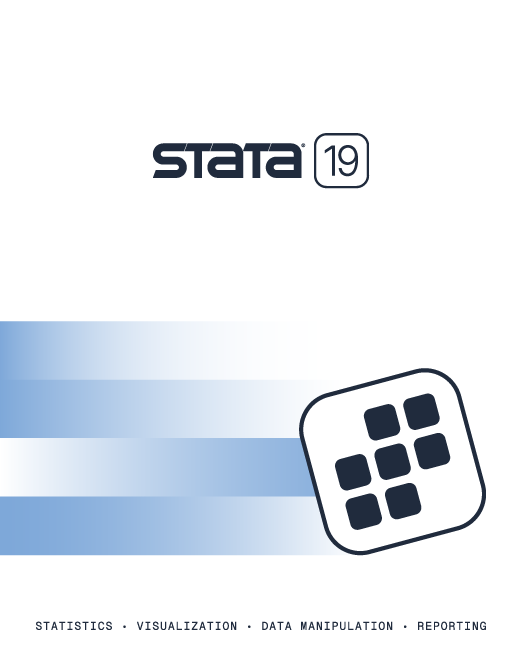

2025 Stata Conference • Nashville, TN • 31 July–01 August
Generalized Linear Models for Bounded and Limited Quantitative Variables |
||||||||||||||||||||||||||||||||
 Click to enlarge |

As an Amazon Associate, StataCorp earns a small referral credit from
qualifying purchases made from affiliate links on our site.
eBook not available for this title
eBook not available for this title |
|
||||||||||||||||||||||||||||||
Comment from the Stata technical groupGeneralized Linear Models for Bounded and Limited Quantitative Variables provides a focused discussion on the theoretical and applied aspects of modeling outcomes with natural boundaries, such as proportions, and outcomes subjected to censoring or truncation. The authors introduce models that use appropriate distributions for various types of bounded outcomes, such as beta regression for outcomes bounded between 0 and 1. They also introduce models such as Tobit models that account for censoring and models that can account for excess observations at boundaries. Researchers and students who have some familiarity with generalized linear models will find this book to be a great resource when they are ready to model bounded and limited dependent variables. The book's companion website provides annotated code in Stata, SAS, and R, as well as the datasets needed to reproduce the examples in the book. These resources make it easy for readers to learn not only the theory behind these models but also the practical aspects of fitting the models and interpreting the results. |
||||||||||||||||||||||||||||||||
Table of contentsView table of contents >> Series Editor's Introduction
About the Authors
Acknowledgments
Companion Website for This Book
1. Introduction and Overview
1.1 Overview of This Book
1.2 The Nature of Bounds on Variables 1.3 The Generalized Linear Model 1.4 Examples 2. Models for Singly Bounded Variables
2.1 GLMs for Singly Bounded Variables
2.2 Model Diagnostics 2.3 Treatment of Boundary Cases 3. Models for Doubly Bounded Variables
3.1 Doubly Bounded Variables and "Natural" Heteroscedasticity
3.2 The Beta Distribution: Definition and Properties 3.3 Modeling Location and Dispersion 3.4 Estimation and Model Diagnostics 3.5 Treatment of Cases at the Boundaries 4. Quantile Models for Bounded Variables
4.1 Introduction
4.2 Quantile Regression 4.3 Distributions for Doubly Bounded Variables With Explicit Quantile Functions 4.4 The CDF-Quantile GLM 5. Censored and Truncated Variables
5.1 Types of Censoring and Truncation
5.2 Tobit Models 5.3 Tobit Model Example 5.4 Heteroscedastic and Non-Gaussian Tobit Models 6. Extensions and Conclusions
6.1 Extensions and a General Framework
6.2 Absolute Bounds and Censoring 6.3 Multilevel and Multivariate Models 6.4 Bayesian Estimation and Modeling 6.5 Roads Less Traveled and the State of the Art References
Index
|
||||||||||||||||||||||||||||||||
Learn
Free webinars
NetCourses
Classroom and web training
Organizational training
Video tutorials
Third-party courses
Web resources
Teaching with Stata
© Copyright 1996–2025 StataCorp LLC. All rights reserved.
×
We use cookies to ensure that we give you the best experience on our website—to enhance site navigation, to analyze usage, and to assist in our marketing efforts. By continuing to use our site, you consent to the storing of cookies on your device and agree to delivery of content, including web fonts and JavaScript, from third party web services.
Cookie Settings
Last updated: 16 November 2022
StataCorp LLC (StataCorp) strives to provide our users with exceptional products and services. To do so, we must collect personal information from you. This information is necessary to conduct business with our existing and potential customers. We collect and use this information only where we may legally do so. This policy explains what personal information we collect, how we use it, and what rights you have to that information.
These cookies are essential for our website to function and do not store any personally identifiable information. These cookies cannot be disabled.
This website uses cookies to provide you with a better user experience. A cookie is a small piece of data our website stores on a site visitor's hard drive and accesses each time you visit so we can improve your access to our site, better understand how you use our site, and serve you content that may be of interest to you. For instance, we store a cookie when you log in to our shopping cart so that we can maintain your shopping cart should you not complete checkout. These cookies do not directly store your personal information, but they do support the ability to uniquely identify your internet browser and device.
Please note: Clearing your browser cookies at any time will undo preferences saved here. The option selected here will apply only to the device you are currently using.